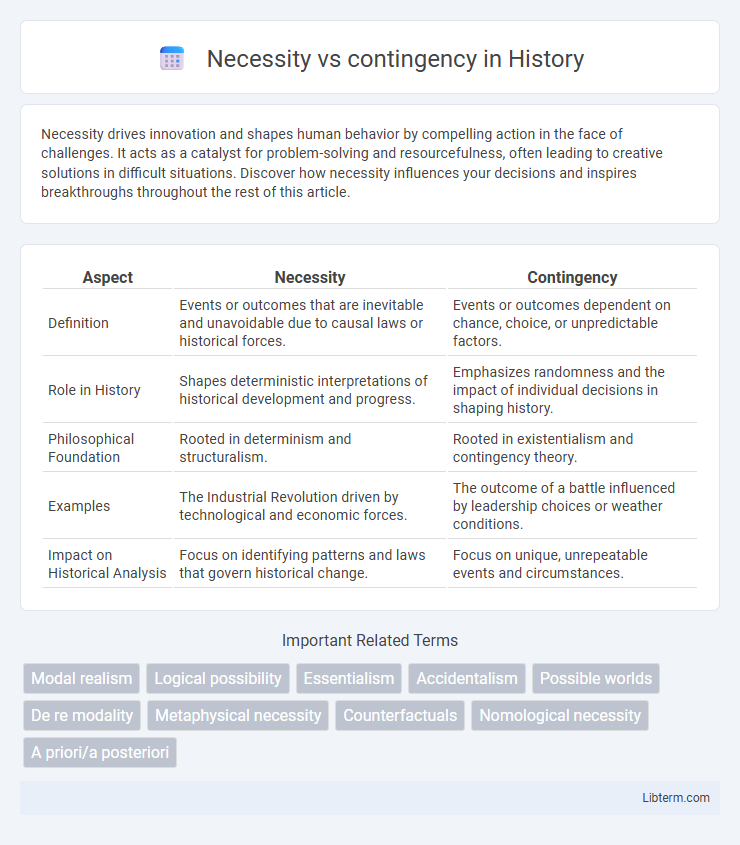Necessity drives innovation and shapes human behavior by compelling action in the face of challenges. It acts as a catalyst for problem-solving and resourcefulness, often leading to creative solutions in difficult situations. Discover how necessity influences your decisions and inspires breakthroughs throughout the rest of this article.
Table of Comparison
| Aspect | Necessity | Contingency |
|---|---|---|
| Definition | Events or outcomes that are inevitable and unavoidable due to causal laws or historical forces. | Events or outcomes dependent on chance, choice, or unpredictable factors. |
| Role in History | Shapes deterministic interpretations of historical development and progress. | Emphasizes randomness and the impact of individual decisions in shaping history. |
| Philosophical Foundation | Rooted in determinism and structuralism. | Rooted in existentialism and contingency theory. |
| Examples | The Industrial Revolution driven by technological and economic forces. | The outcome of a battle influenced by leadership choices or weather conditions. |
| Impact on Historical Analysis | Focus on identifying patterns and laws that govern historical change. | Focus on unique, unrepeatable events and circumstances. |
Understanding Necessity and Contingency
Necessity refers to conditions or truths that must be the case in all possible worlds, exemplified by mathematical facts and logical truths that cannot be otherwise. Contingency involves scenarios or propositions that may or may not be true depending on circumstances, such as historical events or empirical observations subject to change. Understanding necessity and contingency is crucial for distinguishing between what is universally and unconditionally true versus what is dependent on external factors or particular conditions.
Historical Perspectives on Modal Concepts
Historical perspectives on necessity and contingency trace back to Aristotle's distinction between essential and accidental properties, laying the foundation for modal logic. Medieval philosophers like Aquinas and Duns Scotus expanded these concepts within theological frameworks, emphasizing God's role in necessary existence versus contingent creation. Early modern thinkers such as Leibniz introduced possible worlds semantics, refining the understanding of necessity as true in all possible worlds and contingency as true in some but not others.
Defining Necessary Truths
Necessary truths are propositions that hold true in all possible worlds, independent of empirical verification or individual belief. These truths arise from the nature of concepts or logical structures, such as mathematical statements like "2+2=4" or tautologies like "all bachelors are unmarried." Defining necessary truths involves identifying statements whose denial entails a contradiction, thereby distinguishing them from contingent truths that depend on particular circumstances or facts.
Exploring Contingent Facts
Contingent facts depend on external conditions and could be otherwise, contrasting with necessary truths that hold in all possible worlds. Exploring contingent facts involves analyzing specific contexts, causal relationships, and empirical data that determine their truth value. Philosophical inquiry into contingency examines how these facts influence our understanding of reality, chance, and necessity.
Modal Logic: Analyzing Possibility and Necessity
Modal logic provides a formal framework for analyzing necessity and contingency by distinguishing between what must be true and what could be true in different possible worlds. The necessity operator (#) indicates propositions true in all accessible worlds, while the possibility operator (*) marks propositions true in at least one accessible world. This approach enables rigorous examination of metaphysical concepts, such as essential properties and contingent facts, through semantic models like Kripke frames.
Necessity and Contingency in Metaphysics
Necessity in metaphysics refers to propositions or entities that must exist or be true in all possible worlds, reflecting absolute and unalterable truths, such as mathematical facts or logical laws. Contingency involves those that could be otherwise or may exist in some possible worlds but not others, highlighting the dependent or accidental nature of entities and conditions. Understanding necessity and contingency is essential for exploring ontological categories, causal relationships, and modal realities within philosophical inquiry.
The Role of Possible Worlds Semantics
Possible worlds semantics plays a crucial role in distinguishing necessity from contingency by evaluating statements across all conceivable scenarios or worlds. Necessity refers to propositions true in every possible world, while contingency applies to those true in some but not all worlds. This framework enables precise analysis of modal concepts by modeling how truth values vary depending on different hypothetical conditions.
Applications in Science and Mathematics
Necessity and contingency play crucial roles in the formulation of scientific laws and mathematical theorems, where necessity denotes truths that hold universally and contingencies reflect conditions dependent on specific parameters or initial states. In mathematics, necessity is embodied in axioms and proven theorems that are necessarily true within given frameworks, whereas contingencies emerge in applied mathematics when models rely on variable data or assumptions. Scientific applications often distinguish between necessary causal relationships underpinning physical laws and contingent phenomena observable under particular experimental conditions, guiding hypothesis testing and theory development.
Necessity vs. Contingency in Everyday Reasoning
Necessity refers to propositions or truths that cannot be otherwise, reflecting their inherent inevitability, while contingency pertains to states or facts that could have been different depending on various conditions. In everyday reasoning, distinguishing necessity from contingency aids decision-making by clarifying what outcomes are fixed versus those subject to change. This differentiation improves critical thinking, allowing individuals to assess risks, plan effectively, and navigate uncertain scenarios with a clearer understanding of what is logically or empirically determined.
Debates and Challenges in Modal Philosophy
Debates in modal philosophy regarding necessity versus contingency center on the ontological status of possible worlds and the nature of modal truths. Philosophers challenge whether necessity is an intrinsic property of propositions or merely a reflection of linguistic frameworks, raising questions about essentialism and modal realism. These disputes highlight difficulties in defining strict versus logical necessity and the scope of metaphysical versus epistemic modality.
Necessity Infographic

 libterm.com
libterm.com